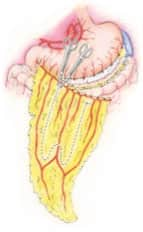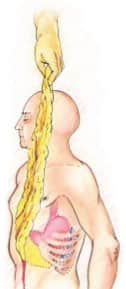Life Extension Magazine®
Dr. Harry S. Goldsmith may be the first to come up with a real treatment for Alzheimer's disease(AD). One of Goldsmith's patients was recently featured on the Channel 2 nightly news in Southern California. The patient, Bernie Weiss, showed striking improvement in before-and-after videos. Channel 2 was so besieged with calls that they had to repeat the segment. Goldsmith, who is at the University of Nevada, has been perfecting the treatment since the 1960s.
The treatment involves placing a part of the body known as the "omentum" directly onto the brain. The omentum is a pocket of fat and blood vessels lying over the intestines like a blanket. That fat around your middle? Part of it is omentum. Goldsmith originally found that he could use the omentum to provoke new blood vessels to grow in areas of the body lacking blood flow. In the late 1970s, he implanted omentum into stroke patients. They improved, and more studies were done in the 1980s. Last year, Goldsmith reported on a patient who was transposed 13 years ago after a stroke. The patient's neurologic function improved, and stayed improved. In 1984, Goldsmith reported that he had isolated an angiogenic (blood vessel-promoting) factor from the omentum. One injection causes new blood vessels to sprout. One striking characteristic of omental tissue is that its arteries never become hardened. Even when a person has atherosclerosis throughout their body, the omental arteries remain pliable.
Goldsmith believes that lack of blood flow is a big factor in AD. So, in 1993 he implanted omentum into a man whose Alzheimer's-like dementia had begun nine years earlier. A single photon/positron emission computed tomography scan (SPECT) showed that blood flow had increased dramatically after the operation, and the man's doctor reported his overall status was "remarkably improved." Among the areas pinpointed for improvement were judgment, confusion, naming and gait. Although the man died two-and-a-half years later from unrelated causes, an autopsy showed that in the area where the omentum had been placed, the number of senile plaques was greatly reduced. In addition, brain cells known as astrocytes were growing. This is extremely unusual in AD patients.
The omentum is a fatty hunk of tissue that not only provokes angiogenesis, it also increases choline acetyltransferase, the enzyme that catalyzes the reaction which creates acetylcholine in the brain. Dr. Goldsmith believes that the ability of omental tissue to provoke this important enzyme is also a factor in why omental transpositions seem to not only arrest AD, but reverse it.
Another aspect of the omentum may be just as important. As strange as it sounds, the omentum is very brain-like. It contains lots of nerves which control the gut. Those nerves, just like the ones in the brain, need nourishment and support. The omentum has a striking ability to generate neurochemicals that nourish nerves and help them grow. One of them, fibroblast growth factor (FGF), has been shown to provoke the growth of new brain cells in areas of the brain affected by AD. The omentum also appears to maintain dopamine, serotonin and norepinephrine when implanted into the brain. So far, there doesn't appear to be much difference in the factors produced by the omentum as the brain. Which means that when omental tissue is transposed to the brain, the brain may benefit from a new influx of growth factors. Dr. Goldsmith is careful to leave the omentum attached to its original blood supply so as to maintain its integrity, when he does the surgery.
In addition to helping stroke patients, omental tissue has the potential to repair spinal cord injuries. Some of the same factors that provoke new brain cells into growing also provoke new axons to grow in spinal tissue, according to research done by Goldsmith.
| ||||||||||||
References
Goldsmith HS, et al. 1999. Omental transposition for cerebral infarction: a 13-year follow-up study. Surg Neurol 51:342.
Goldsmith HS. 1997. Omental transposition to the brain for Alzheimer's disease. Ann NY Acad Sci 826:323.
Goldsmith HS. 1996. Omental transposition for Alzheimer's disease. Neurol Res 18:103.
Goldsmith HS. 1994. Brain and spinal cord revascularization by omental transposition. Neurol Res 16:159.
Goldsmith HS, et al. 1992. Axonal regeneration after spinal cord transection and reconstruction. Brian Res 589:217.
Goldsmith HS. 1990. [Lack of atherosclerosis in omental arteries]. Lancet 335(8686):409.
Goldsmith HS, et al. 1990. Regional cerebral blood flow after omental transposition to the ischaemic brain in man. A five year follow-up study. Acta Neurochir (Wien) 106:145.
Goldsmith HS, et al. 1986. Increased vascular perfusion after administration of an omental lipid fraction. Surg Gynecol Obstet 162:579.
Goldsmith HS. 1980. Salvage of end stage ischemic extremities by intact omentum. Surgery 88:732.
Konturek SJ, et al. 1994. Omentum and basic fibroblast growth factor in healing of chronic gastric ulcerations
in rats. Dig Dis Sci 39:1064.
Ohtaki T, et al. 1989. Purification of acidic fibroblast growth factor from bovine omentum. Biochem Biophys Res Commun 161:169.
Pau A, et al. 1982. Effect of omental transposition on to the brain on the cortical content of norepinephiine, dopamine, 5- hydroxytryptamine and 5-hydroxyindoleacetic acid in experimental cerebral ischaemia. Acta Neurochir (Wien) 66:159.
Relkin NR, et al. 1996. Decreased senile plaque density in Alzheimer neocortex adjacent to an omental transposition. Neurol Res 18:291.



